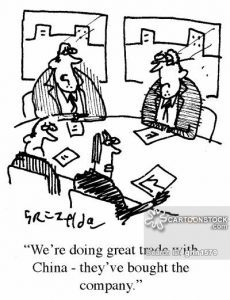Report filed by our trade correspondent, L.C.

‘We’re doing great trade with China – they’ve bought the company.’
January could see a major stock market correction depending on how the Trump administration handles a slew of protectionist trade measures with deadlines scheduled for this month. Most of the measures are aimed at the Chinese and could trigger Chinese retaliations.
The year 2017 ended with a flurry of articles in the press anticipating that President Trump would finally make good on his threats to take action on trade and against China early in 2018. The approach of the one-year mark in his presidency and the opportunity of the January 30th State of the Union address to vaunt his moves on trade add to the expectation for January action. This expectation is also buttressed by the tough anti-China rhetoric surrounding the December 18th release of the Administration’s National Security Strategy, as well as by Administration sources quoted in the press.
But January action had long been on the schedule for new trade moves anyway, in part because of some set deadlines, and also due to the completion of action on tax reform. Until the tax bill was enacted, the President had been persuaded not to do anything controversial that might upset some legislators whose votes were needed. The President had been further constrained by his hope that Beijing would help him in containing the North Korean threat. But that hope, he declared this week, has been disappointed.
Disagreement among the President’s advisers
Some of the press report that there is still strong disagreement among Trump advisers over what to do on trade. In the wake of successful tax reform, Axios reports, National Economic Council Director Gary Cohn and Treasury Secretary Steve Mnuchin are now trying to restrain Trump’s inclination for broad trade actions by arguing that they would hurt the stock market and undercut benefits of the tax bill. The two advisers are trying to steer the President toward limited, targeted actions that wouldn’t threaten a global trade war and economic instability. If these accounts are accurate, the President hasn’t made his final decision on a course of action. However, the time for decision is approaching fast.
Under consideration are actions against Chinese exports to the US of steel, aluminum, solar cells and modules, and large residential washing machines. The steel and aluminum measures are an attempt by the US government to penalize China for its metal sector overcapacity. So far there haven’t been any effective international efforts to do this.
One possible Administration response that would bring less likelihood of Chinese retaliation and would have much domestic support across-the-board (Democrats and Republicans, US exporters and companies that invest in China) would be to tighten the process for approving foreign investment in the US. The obvious target would be Chinese attempts by state-controlled entities to acquire US companies with high-tech, innovative, or military and communications-related assets. Bills to tighten the functioning of the Committee on Foreign Investment in the US (CFIUS) have been introduced, and the most likely one to pass now has Administration support. But the President could also issue an executive order affecting some of the CFIUS’s functioning. So CFIUS reform should be expected early in the new year, and it would be especially welcomed if it were undertaken instead of unilateral trade measures.
Administration stance toward World Trade Organization (WTO) still unresolved.

WTO headquarters, Geneva, Switzerland
Also coming up in 2018, the Trump Administration has to decide how to respond to and use – or not – the WTO. This is not just an ideological question but involves practical decisions that must be made regarding WTO cases involving the US.
There are over a dozen currently active cases in which the US is either complainant or defendant. In the former, the Administration must decide if it wishes to pursue cases filed by its predecessor, and also if it wishes to file new complaints. It filed none in its first year but recently indicated it will pursue the cases against Canada for grocery store discrimination of foreign wine and against China for agricultural tariff-rate quotas. It will also continue steps in the seemingly endless US-EU dispute over aircraft subsidies.
And it is considering pursuing the case against China’s aluminum subsidies. This last would be significant in that it could mark a turn toward trying to use the WTO more forcefully in key disputes with China, a potential alternative to unilateral action – and it could indicate if the WTO is useful against problems of subsidies and excess capacity. Meanwhile, the US will also be defending itself in the case China brought against Washington’s refusal to grant it market-economy status. This issue is the one that could provoke an existential crisis for the WTO. US Trade Representative (USTR) Robert Lighthizer has charged that a negative ruling would be “cataclysmic” for the institution.
USTR will also have his hands full defending against complaints by allies.
Filing new WTO cases would fit with the President’s prioritization of trade enforcement, though it would conflict with his stated disdain for the WTO. Still, using the WTO for enforcement would be considered by many a useful way to adhere to the President’s tough enforcement promise.But if Washington is to use the WTO at all, it must find a way to resolve its dispute over the appointment of Appellate Body judges, since that clash by itself could paralyze the WTO’s key function, dispute settlement.
North American Free Trade Association (NAFTA) and Korean-US Free Trade Agreement (KORUS)
The difficult posture the US has taken in the NAFTA renegotiation has discouraged other trading partners from entering negotiations with Washington, and it is likely that there won’t be formal trade agreements talks with any trading partners other than the re-do efforts on NAFTA and KORUS during 2018.
Both those renegotiation efforts will hold formal sessions in January. The US and South Korea hold their third meeting on January 5th and the 6th NAFTA renegotiation round is set for Montreal, January 23-28. As the new year begins, both face daunting problems and will fail unless the US shows more flexibility than it has so far indicated. The list of US NAFTA positions unacceptable to Canada and Mexico is long, and the US focus on the bilateral trade deficit and push to further open Korea’s agricultural market are non-starters for Seoul. Political factors centered about the July 1st Mexican presidential election and the North Korea crisis would appear to militate in favor of US flexibility, but recent statements by President Trump do not suggest this dynamic is at work (at least not yet). Prospects for success of both efforts should be clarified by the January meetings.
Click here to go to the previous post (“Fourth day of spontaneous demonstrations against hated Iranian regime”)

Leave a Reply